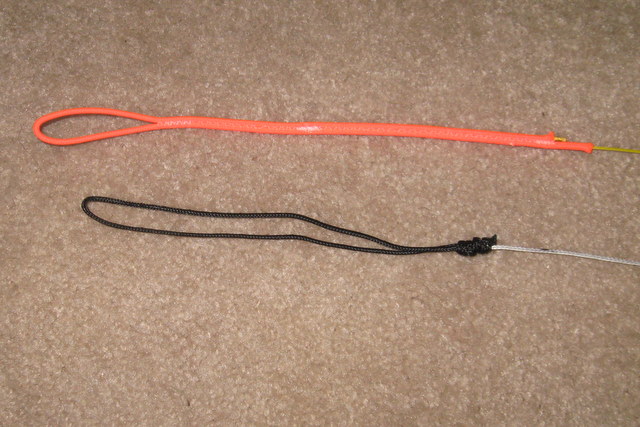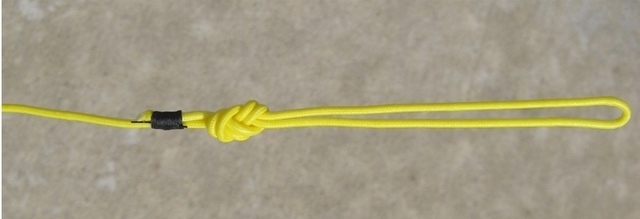
Dyneema (c) is a registered trade name of the Dutch company DSM Dyneema, B.V. They have a factory in Greenville, NC, U.S.A. All the European brands of kiteline sets that we know of are made of Dyneema.
Spectra (c) is a registered trade name of the U.S. firm Honeywell International Inc.
Both are fibers independently developed by their respective manufacturers and while their production details likely differ, both are made of Ultra High Molecular Weight Polyethylene, or UHMWPE fibers. The following shared characteristics make them perfect for kite lines and bridles:
 |
| An example of sewn sleeved loops (top) and knotted loops (bottom). The sewn loops are joined with a zig-zag stitch and the knotted loops are secured with a figure-eight knot or in this case, a couple of overhand knots. Sleeving is usually woven dacron. |
While Dyneema and Spectra exhibit low stretch, any stretch at all caused by the stresses of flight can de-tune a bridle or cause flight lines to be mismatched in length. For this reason, any reputable manufacturer will pre-stretch their lines before assembly so that their kites will better maintain their flying shape and trim characteristics. Fans of Spectra will point out that it will stretch only about 3%, or about half as much as Dyneema. Laser Pro Gold is a popular brand of Spectra that is specifically woven for kite flying and is standard on Revolution kites. If you have ever seen precision flight teams like iQuad fly their Rev's, you will appreciate the need for for the precision feel that comes from low stretch.
A North American brand of line popular with kiteboarders and kitesurfers is Q-Powerline from Q-Power Sports. They are based in Canada with distribution within the US. Q-PowerLine features a spectra core surrounded by a braided spectra sheath. The sheath is woven tightly with fibers at ninety degree angles, forming a tight barrier that won't let even the finest beach sand in to abrade the fibers of the inner core. Another advantage of the sheath is that it allows you to tie knots to form loops at the ends without additional braided sleeving. This makes it easy and economical to buy bulk spools and make your own custom line sets. They also make Q-PowerLine Pro, a premium grade of the line that is 33% thinner for the same strength as the regular Q-PowerLine. You can see our catalog offering of Q-Power products here.
 |
| An example of a knotted loop formed in Q-PowerLine. Becuase the entire line is shaethed, no external sleeving is needed. The knot is a figure-eight knot and the free end is whipped (wrapped) with thread so that it does not become a hook to snag another line. Looks neater too. |
Back to Tutorial Menu
Back to Coastal Wind Sports Home Page
| utah homes |